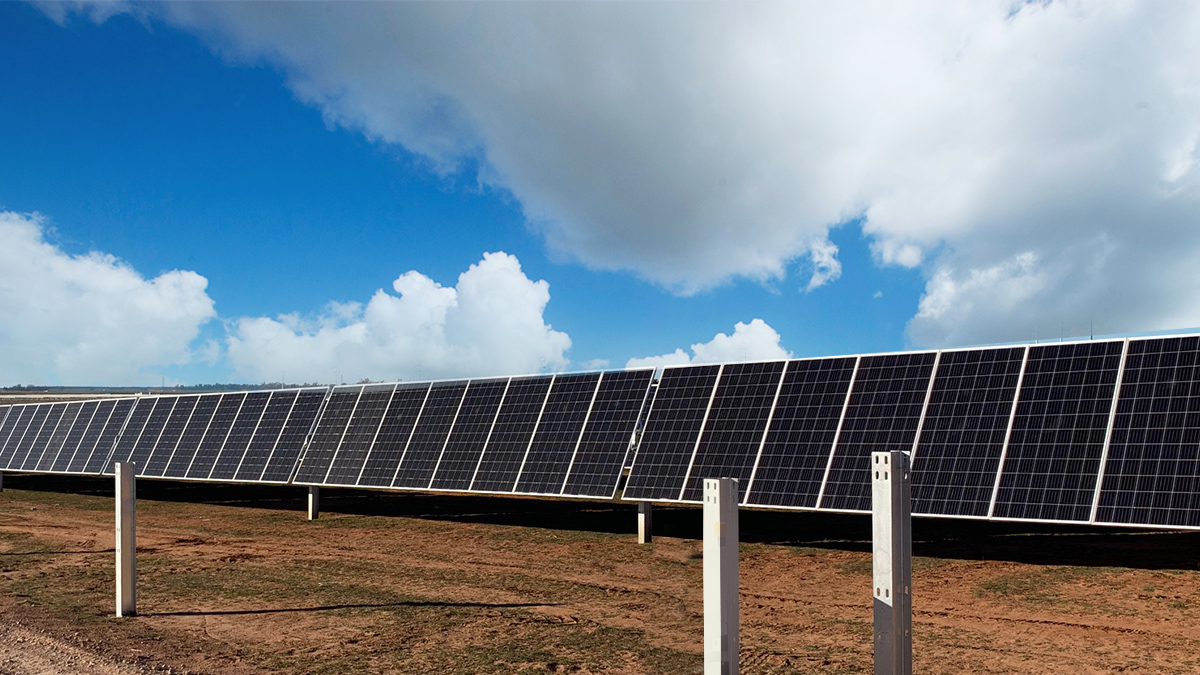
UNSW Sydney researchers pioneered the development of solar photovoltaic technology, which is now helping the University achieve net zero emissions from energy use.
In 2018, President and Vice-Chancellor Professor Ian Jacobs announced that UNSW Sydney would achieve net zero emissions from energy use by 2020. In November, the University made this vision a reality when the Sunraysia Solar farm started exporting electricity to the grid. The solar farm supplies UNSW’s energy through an innovative solar Power Purchase Agreement (PPA). In addition to renewable electricity, UNSW purchases additional carbon units to offset emissions from natural gas and other fuels.
This landmark will see the University save 1.25 million tonnes of greenhouse gas (GHG) emissions over the 15-year term of the PPA.
“This is the next step on the journey UNSW has taken over recent years to help in addressing the climate crisis, both as a world-class academic institution and as an organisation with a significant carbon footprint. Switching to provision of our entire on-campus electricity supply through solar renewable energy is a landmark step for UNSW,” said Professor Jacobs.
“It is fitting in the context of UNSW’s long history of pioneering work in the development of solar photovoltaic technology, which has just been recognised by the award of the Japan Prize to Scientia Professor Martin Green,” he said.
Tackling climate change is a key focus in UNSW’s 2025 Strategy and Environmental Sustainability Plan 2019-21. The move follows a UNSW announcement in 2020 that it would divest of all fossil fuel company investments by 2025.
Jeff Peers, UNSW Chief Technology and Infrastructure Officer, said that switching to renewable energy is a major step in the University's response to climate change.
“Through the solar farm we are switching to 100% renewable electricity, by retiring Large-scale Generating Certificates received under the PPA equivalent to our total electricity consumption. In addition to energy efficiency and onsite solar initiatives, we purchase additional carbon credits to offset our remaining emissions from gas and other fuels,” Mr Peers said.
UNSW has spearheaded research into solar PV technology
UNSW’s School of Photovoltaic and Renewable Energy Engineering (SPREE) was particularly eager to see the farm go live: it is their PV technology which is now used to light up and power their offices and the rest of the University.

The hundreds of rows of perfectly spaced, blue solar panels now cut a striking image against the flat dry yellow grass of the outback. This is a vision UNSW researchers had decades ago in the 1980s.
UNSW researchers in SPREE, led by Scientia Professor Martin Green, pioneered the world’s first 19% and 20% efficiency solar cells in 1983 and 1985 respectively, eventually taking efficiency to 25%.
Forty years later, their dream of using solar power to provide affordable and reliable electricity is a reality.
“The research was commercialised in the 1990s in China by UNSW researchers, which later allowed solar panels to become affordable at scale,” said SPREE Head, Professor Alistair Sproul.
In 2001, Scientia Professor Martin Green and the late Professor Stuart Wenham helped the team of UNSW Sydney graduates – Zhengrong Shi, Ted Szpitalak, Fengming Zhang, Huaijin Yang, and Chengrong Xu – to set up the first commercial solar cell company in China: Suntech Power.
The team then founded another solar panel manufacturer, China Sunergy, with further recruits from SPREE, with the process repeated for JA Solar and Sunrise Global.
The industry grows through the global financial crisis

In the largest technology float of 2005, Suntech sold shares on the New York Stock Exchange (NYSE) in 2004 and raised $396.5 million.
By 2008, nine Chinese photovoltaic companies were listed on the NYSE, six with Chief Technical Officers from UNSW’s pioneering team.
“America financed these solar companies, all set up in China, through the NYSE and NASDAQ,” Professor Green said. “With total investment of $10 billion in cell shipments, we went from 60 megawatts in 2005 to 11,000 megawatts in 2011.”
Suntech grew to become the world’s largest manufacturer in 2010 with JA Solar in second place. Both companies are founded by UNSW Sydney alumni.
Solar cells become cheap enough to farm sunshine at scale
In 2016, UNSW President and Vice-Chancellor Professor Ian Jacobs went out to the arid, sun-drenched landscape to see one of UNSW’s remote field stations in north-western New South Wales.
This bleak landscape held the potential for an entirely solar-powered UNSW.
UNSW Vice-President of Operations Andrew Walters and UNSW’s Energy Manager Nicholas Jones researched the market and developed a 15-year Power Purchase Agreement (PPA) with Chinese-Australian developer Maoneng and Origin Energy.
“With the 15-year PPA, UNSW Sydney will utilise up to 52-megawatts of electrical power from Sunraysia Solar Farm to generate 125 gigawatt hours a year,” Mr Jones said.
“In round terms that means we’ll save about 85,000 tonnes of carbon emissions a year. Over the 15-year life of the PPA, UNSW is on target to save 1.25 million tonnes of carbon emissions. With all energy coming from the power of the sun, solar power is the cleanest form of energy we can use.”
UNSW to draw on 25 per cent of solar farm’s total output

The 1000 ha Sunraysia Solar Farm in Balranald south-west NSW is owned by John Laing and Maoneng, and is one of the largest in the world. Construction finished in late 2019 and it was connected to the electricity grid in November 2020.
The 755,000 ground-mounted solar panels now track the sun’s rays and generates up to 65 megawatts of solar energy. However, it will ramp up to 200 megawatts – its maximum power output – once the network commissioning process is completed.
This means that over a year the farm will generate enough electricity to power 50,000 homes, the equivalent of 12 suburbs.
UNSW uses just a quarter of the farm’s capacity to meet 100% of its electricity needs, reducing its energy-related carbon emissions to net zero.
A tribute to UNSW’s Professor Green and his team of researchers

The PPA specified that the UNSW-dedicated section of Sunraysia Solar Farm, Block 13, comprised the UNSW-developed Passivated Emitter and Rear Cell (PERC) solar technology.
“When they were building the farm, it’s likely that there was a module which was cheaper. But now, PERC really is the cheapest to make,” Professor Sproul said.
“I feel really proud of the global impact we have been able to have on the solar panel industry with our research,” Professor Green said.
“Not only have my former students set up the companies that have now made solar the cheapest source of electricity, but our PERC cell now accounts for 80% of worldwide manufacturing capacity, with this still increasing.”
- Log in to post comments
